Commencing its life with a beat of just 4.77MHz, the central heart of the PC is now racing at well over 5GHz, and with multiple cores under its hood too. The last four decades have seen a silicon revolution, as PC users demanded more and more power over the years, spurring on several major innovations and new approaches to computing.
Along that journey we’ve seen hundreds of CPUs from various different manufacturers, with huge increases in clock speeds and core counts. Some of these chips have really stood out above the rest, though, whether it’s because they introduced us to brand new architectural designs or features, pushed the boundaries of performance, or simply because they offered phenomenal value for their specs. Accordingly, we thought it was about time we rounded up the very best of the best, and share the chips that have had the biggest impact in the world of PC hardware enthusiasts.
For simplicity’s sake, we’re sticking to x86 CPUs for this feature. There’s certainly a case for several other non-x86 CPUs being in a top ten, from the first Acorn Archimedes Arm chips to the Apple M1, as well as the widespread Motorola 68000, just to name a few. And yes, we’re also well aware that the term ‘PC’ doesn’t just apply to x86 machines running Windows. However, as we’re mainly PC enthusiasts here, and there are rich pickings in the x86 legacy, we’re only going to focus on core PC hardware. Anyway, enough chatter, here are the finest PC processors ever.

10. Intel Pentium G3258 Anniversary Edition
Every now and then an absurdly cheap CPU comes along that makes its pricier siblings look outright silly, and the finest example is Intel’s Pentium G3258 Anniversary Edition. You usually need to fork out the extra cash for a K-series CPU to get an unlocked multiplier, but Intel decided to make this cut-price dual-core CPU easily overclockable too. If you were prepared to get your hands dirty in the BIOS, you could get an amazing CPU for an absolute bargain price.
Launching for just £52.99, Intel’s Pentium G3258 had an almost-throwaway cost, but the Haswell chip under its heatspreader could be clocked to high heaven. It only boosted to 3.2GHz at stock speed, but you could happily crank it well past the 4GHz mark, and often much higher, with only a modest air cooler strapped to it.
The Haswell chip under its heatspreader could be clocked to high heaven
Back in 2014, most games didn’t benefit from having more than two cores, either, enabling you to build a bargain-basement blaster that could handle the latest games surprisingly well, as long as you had a half-decent GPU. It was a fantastic gift to enthusiasts looking to put together a budget gaming rig, and it made Intel’s more expensive, multiplier-locked Core i3 chips look positively redundant.
It’s been a while since we had a true budget gaming CPU for enthusiasts. Please can we have another one of these when Nova Lake comes out, Intel?

9. Intel Core i5-2500K
Intel was on a roll when it released its acclaimed Sandy Bridge architecture in January 2011, with huge performance and sky-high overclocking headroom. Several of the chips were good, but the Core i5-2500K was really something special. Despite its generous £168 launch price, it still had the same four cores as the pricier Core i7-2600K. It just lacked support for Hyper-Threading, meaning it could only execute four concurrent threads, and it had a lower boost clock of 3.7GHz compared to 3.8GHz.
At the time, though, none of this really mattered to most people. Hyper-Threading gave you a performance boost in multi-threaded software, but it made no meaningful difference to games. Clock speed was also a moot point, as the 2500K also had an unlocked multiplier, and boy could it overclock.
You could achieve an all-core overclock to 4.5GHz using just an air cooler
Unlike Intel’s later Ivy Bridge CPUs, these chips still had a soldered connection between the CPU die and heatspreader, rather than using cheap thermal paste, and the overclocking headroom was huge. You could achieve an all-core overclock to 4.5GHz using merely an air cooler, and go even higher with liquid cooling. The performance was amazing for the money, particularly in games, which responded really well to all those extra megahertz.
Meanwhile, AMD was scrambling to make ends meet after spending a fortune on buying ATi, and then launching the underwhelming (to put it kindly) Bulldozer architecture later in 2011. Intel was riding high, and AMD wasn’t able to fight back until it launched its first-gen Ryzen CPUs some six years later.

8. Intel Pentium 90
When id Software released Quake in 1996, there was a new and very specific point on the system-requirements sticker. This game required a CPU with a floating point unit (FPU) to execute, and while it would just about run on a 486 DX4/100, you really needed a Pentium to get the most out of it. Until this point, desktop CPUs were primarily integer calculators, with the option to add a floating-point unit by installing a maths co-processor later. The landscape was changing now, though, and even games were demanding an FPU to crunch through numbers with decimal points. At this point, there was only one option that really did the job – Intel’s new Pentium architecture.
It was a close call between this chip and the 486 DX2/66 making it onto this chart, but in the end, the Pentium clearly wins. Yes, 486 DX chips had an integrated FPU, but there were still loads of 486 SX chips that didn’t. Pentium, on the other hand, made an integrated FPU a core part of the architecture, and it was a good one too.
Even games were demanding an FPU to crunch through numbers with decimal points
Comparatively, AMD’s equivalent K5 chips had weaker floating-point performance, and Cyrix’s 5×86 CPUs were even worse, making Quake practically unplayable on anything other than a Pentium. It also helped that Intel had accompanied the launch with a big-budget, ingenious marketing campaign, including very fancy TV ads, ensuring that ‘Intel Inside’ was embedded into your consciousness when you went out to buy a PC.
The lineup was available in several clock speeds, too, starting at 60MHz and eventually topping out at 233MHz with the final MMX lineup, but it was the Pentium 90 that really hit the sweet spot. You could still get away with a basic heatsink and no fan when your CPU was only running at 90MHz, and that clock speed still made Quake run smoothly, without the substantial extra cost of buying a 100MHz+ CPU. Later on, a 90MHz Pentium also gained you entry to the 3dfx club, being the claimed minimum chip required to run games well with a Voodoo 3D graphics accelerator.
But at this time, any Pentium CPU was still a good buy. I only had a Pentium 75, but it still ran Windows 95 smoothly and coped really well with Quake, and later Quake 2 with a Voodoo card in tow. Intel was on top of the desktop computing world at this point, and it was many years before it had any serious competition.
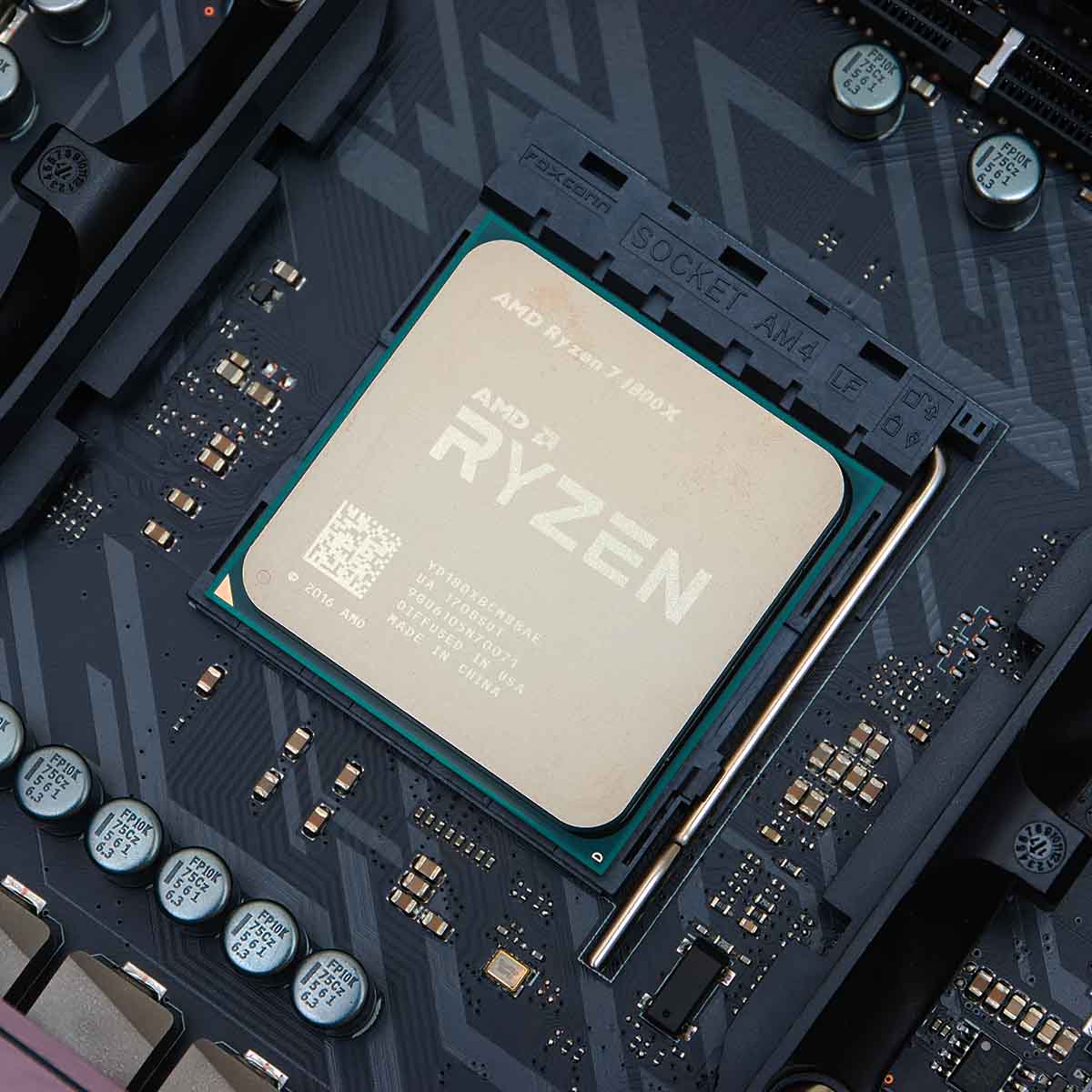
7. AMD Ryzen 7 1800X
AMD was in trouble in 2017, posting a $51 million net loss at the start of the year. Its core Bulldozer architecture had failed to set the world alight, with its FX desktop CPUs having to be sold at bargain prices, while Intel’s chips were making the big bucks. AMD had also lost a lot of money buying ATi – a gamble that, at this point, hadn’t paid off. After spinning off its fabs, creating GlobalFoundries in the process, AMD bet the house on Zen, a new CPU architecture that it hoped could take the fight to Intel. It looked like a last roll of the dice for AMD, but it came up with a double six, thanks to chief designer Mike ‘Father of Zen’ Clark’s forward-looking vision.
Of course, it helped that Intel had been resting on its laurels for several years, with its mainstream desktop CPUs barely offering anything more than Sandy Bridge. Quad-core CPUs were still the standard for Intel’s regular desktop chips six years later, and there was no competition to prove otherwise. If you wanted more cores, you had to spend the extra cash on an Intel HEDT CPU instead.
Spotting a gap in the market, AMD went on an all-out multi-threaded assault
Spotting a gap in the market, AMD went on an all-out multi-threaded assault. Just as it had done with Athlon 64 bringing 64-bit instructions to mainstream computing, AMD judged that consumer desktops were ready for more than four cores. The first generation of AMD Ryzen chips topped out at eight cores on the Ryzen 7 1700X and flagship 1800X, and they were all actual cores too – not just dual integer units with shared FPUs, as we’d seen on AMD’s previous FX chips.
There was even SMT, AMD’s equivalent of Hyper-Threading, to improve multi-threaded performance further. Most importantly, AMD’s new Zen architecture turned out to be amazing, with a massive increase in instructions per clock (IPC) compared to Bulldozer. The benchmarks spoke for themselves, especially when it came to multi-threading. Zen chips weren’t just obliterating Intel’s quad-core mainstream chips, but they were also beating its expensive HEDT chips like the Core i7-6900K in Cinebench, all for a much cheaper price.
Sure, there was room for improvement. First-gen Ryzen CPUs lacked the high clock speed and single-threaded performance of Intel’s processors, meaning the latter were still better for games, and there were some teething problems with high-speed memory, as well. That all changed as AMD refined the Ryzen formula over the next few years, though, and it hasn’t looked back since.

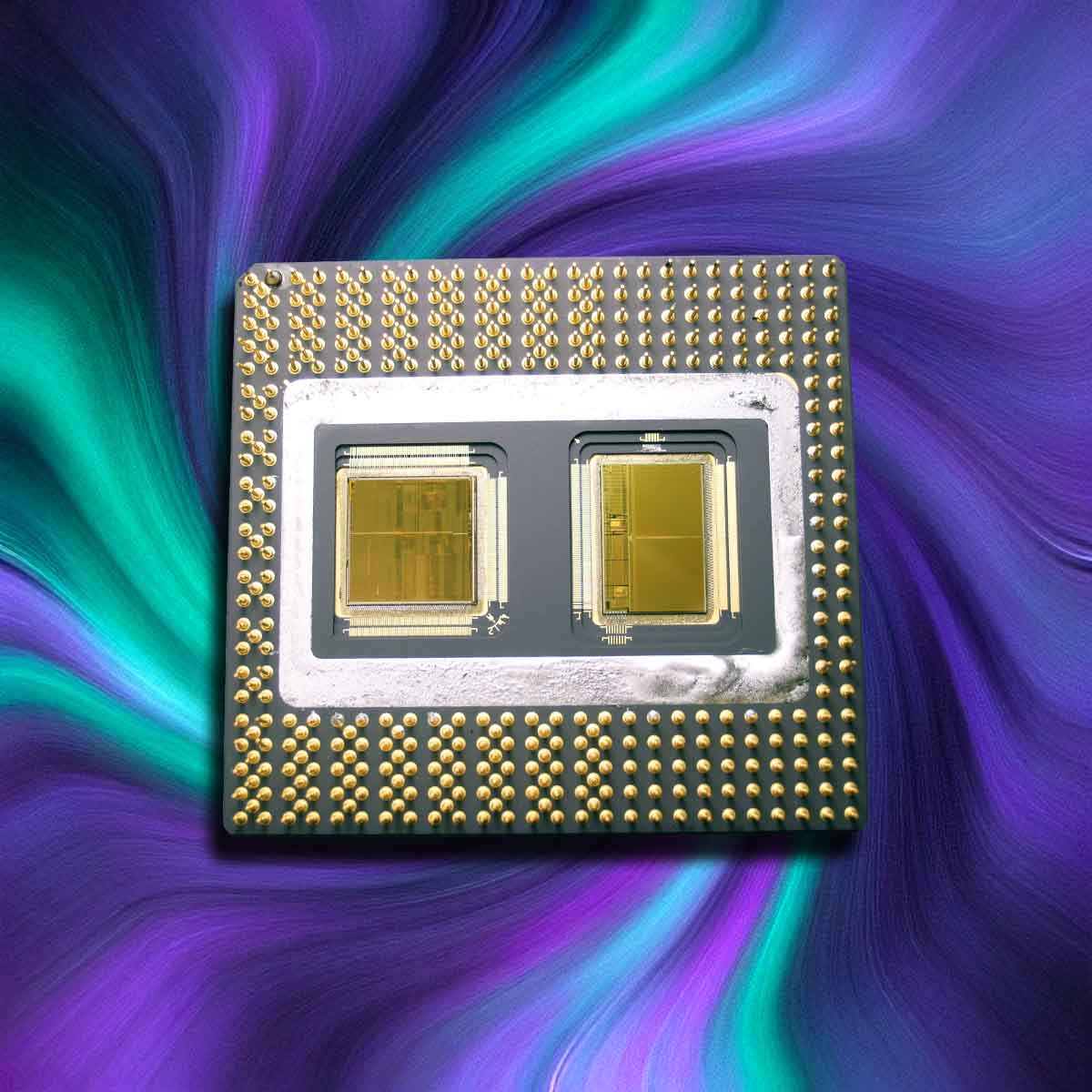
6. Intel Pentium Pro
Pentium Pro might not have been a raging success when it first launched 30 years ago in 1995, but it introduced several new standards we take for granted now, from local L2 cache to multi-threading over multiple CPU cores. In fact, the P6 core at its heart was so good, Intel returned to it ten years later when it finally abandoned Pentium 4.
Until this point, you didn’t get L2 cache on your CPU. Instead, a standard Socket 7 Pentium chip just had L1 cache, and you could add L2 cache yourself (on a stick) in a slot on the motherboard, with all the latency that entails. It seems ridiculous now. Instead, Pentium Pro gave you up to a massive 256KB, 512KB, or even 1MB block of L2 cache. It wasn’t on-die, but it was built into the same package as the CPU, meaning much quicker access then going through the motherboard.
Motherboards came with one, two, or even four sockets for these mammoth CPUs
Meanwhile, floating-point performance was significantly improved compared to a standard Pentium chip, making it ideal for CAD and 3D rendering workloads. Not only that, but you could also pair several Pentium Pro chips together to work in parallel in servers and workstations. Motherboards came with one, two, or even four sockets for these mammoth CPUs. Pentium Pro’s slick pipeline design, which was specifically engineered for out-of-order execution, and could operate on two instructions at the same time, made it a formidable chip in terms of performance.
The main problem, other than its high price, was that while Pentium Pro was a fantastic 32-bit CPU, it struggled with running 16-bit code, particularly when its pipeline was trying to process a mix of 16-bit and 32-bit instructions. This was a common occurrence in the mid 90s, when we’d only just got Windows 95, and were still using this 32-bit OS to run old Windows 3.1 and even DOS software. Intel fixed that with the later Pentium II, but it was Pentium Pro that laid the foundations for all the other good stuff. Ahead of its time, and packed with innovations, we salute you, Pentium Pro.
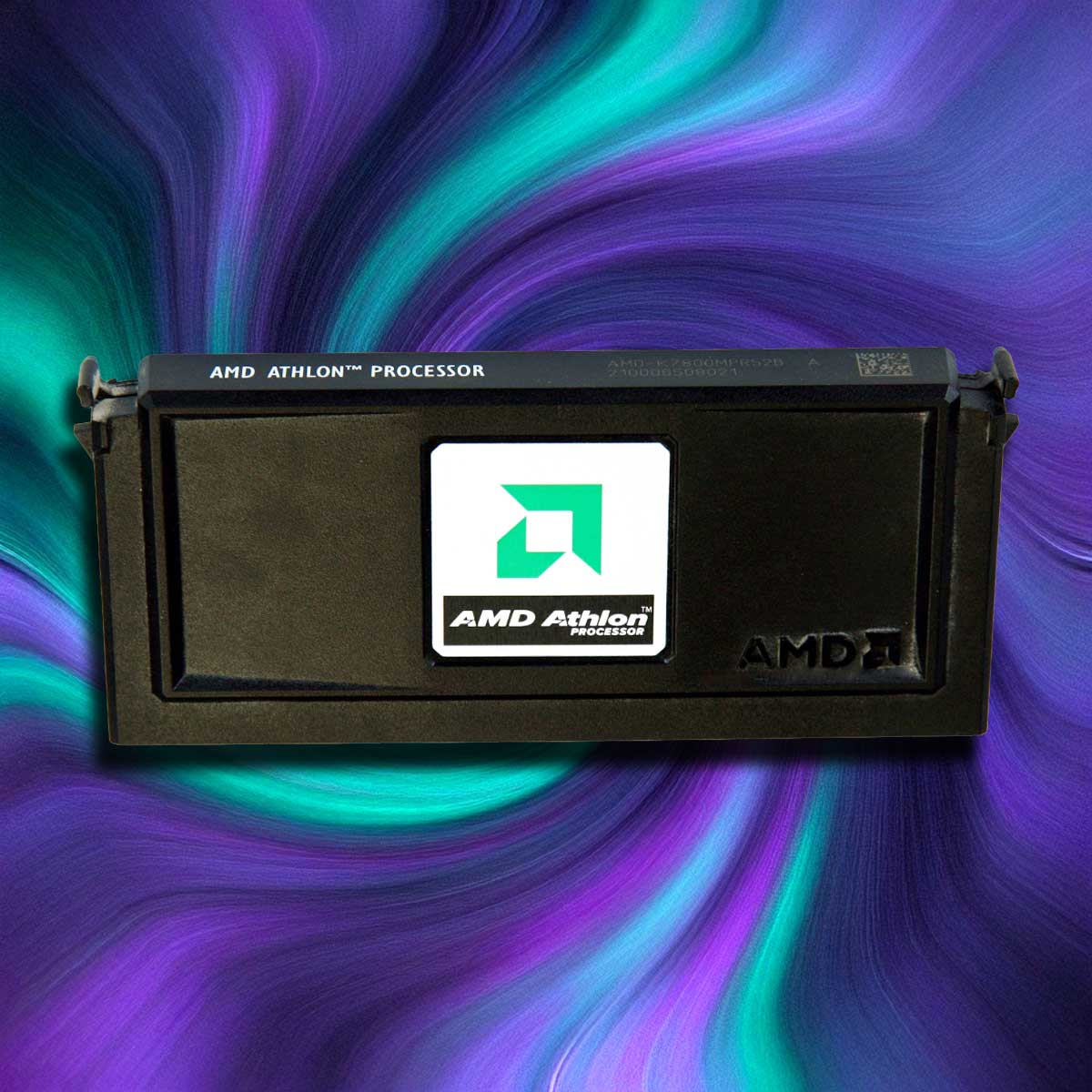
5. AMD Athlon 1GHz
1999 was the year when AMD seemingly decided it was sick of playing second fiddle to Intel. It wanted to be taken seriously as a chipmaker, and not just by cash-strapped gamers looking for cheap Socket 7 chips. The result was the K7 architecture, sporting AMD’s athletic new Athlon brand. Like Intel’s Pentium II and III chips, the first Athlon CPUs came in slot format. This was basically a PCB that slotted into your motherboard, with the core chip in the middle, and 512KB of L2 cache in separate chips on the PCB. At the time, there was no way you could get that much cache into a CPU die – fabrication technology was limited to a space-guzzling 180nm, compared to a scant 3nm today.
While there were a load of teething problems and compatibility issues with Athlon, not least from the accompanying Irongate chipset, AMD had clearly made a very powerful architecture that often outperformed Intel’s chips. I remember testing PCs with the first Athlon CPUs against Intel’s Pentium III Katmai chips in 1999, and clock-for-clock, the Athlons were faster in games such as Quake II, and also quicker at good old-fashioned number crunching, particularly in floating-point operations.
Embarrassingly for Intel, the 1GHz Athlon came out two days before the 1GHz Pentium III
More embarrassingly for Intel, the 1GHz Athlon came out two days before the 1GHz Pentium III. This was a big deal in a time when clock speed was everything – 1,000MHz seemed unfeasibly fast to an industry used to triple-figure clock speeds, and 1,000 was a big, round, significant number. AMD got there first, and it had decent availability too.
Working as a tech journo at the time, I remember it being incredibly hard to find a 1GHz Pentium III review sample, with most of them being allocated to system builders, but there were plenty of 1GHz Athlons to go around. For the first time, AMD had stolen Intel’s thunder and leapt ahead, setting the scene for the back-and-forth CPU battles of today.
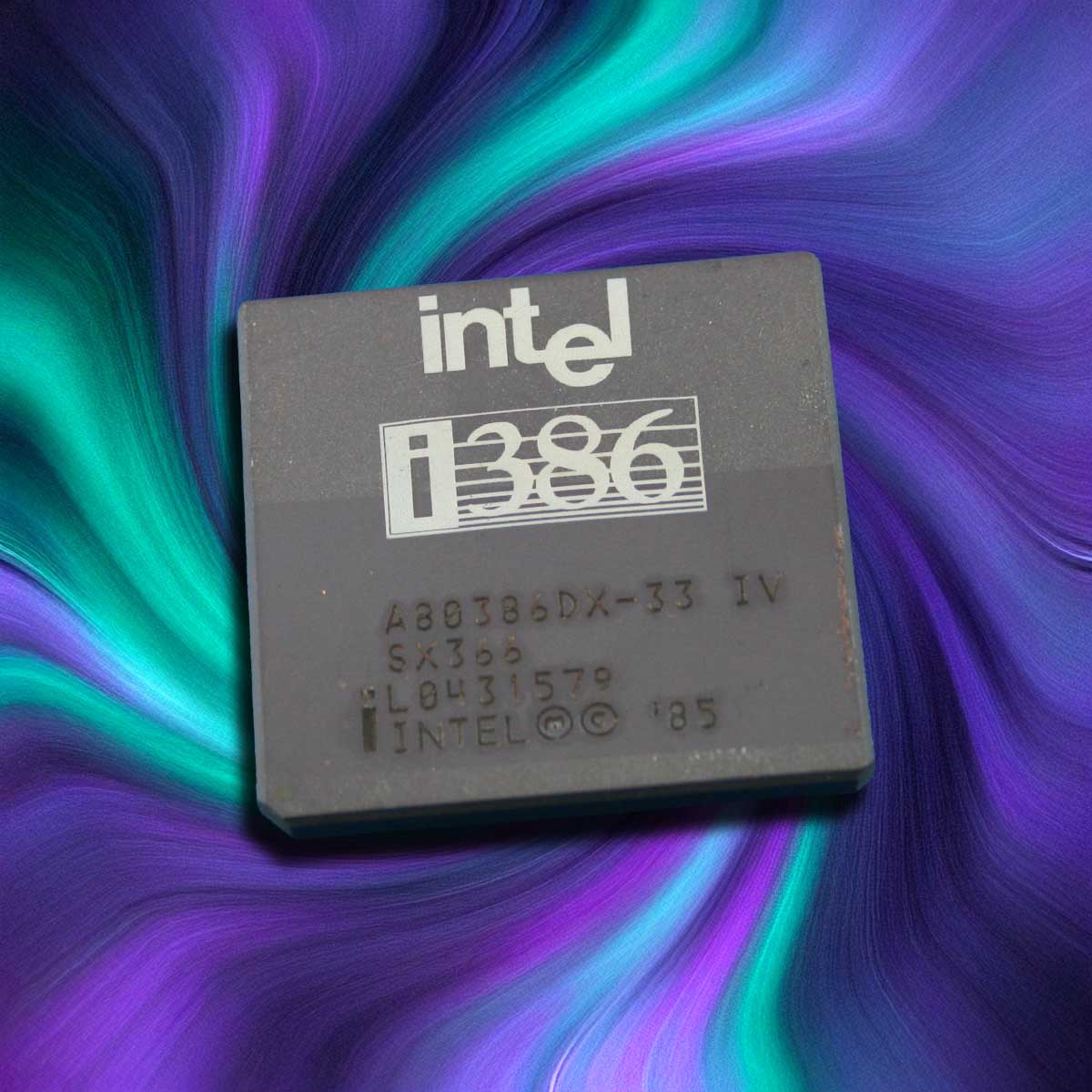
4. Intel 386
There’s a reason why we named our site after this classic PC chip – it’s a bona fide legend. The 386 was so far ahead of its time when it launched in 1985, Microsoft would take another ten years to produce a mainstream Windows OS that could properly take advantage of it. Intel’s first 32-bit x86 CPU was an amazing feat of engineering, finally bringing PC memory management into a new era, and taking PCs beyond the frustrating limits of 16-bit processing. Envisioned by lead architect John Crawford, a certain Pat Gelsinger – who would go on to become a future Intel CTO and CEO – was a key design engineer of the much-vaunted and cherished 386. Here’s to you, Pat.
First came the 386 DX which, unlike the 486 DX, didn’t have an integrated FPU. Instead, that DX suffix referred to the data and address bus widths, both of which were fully 32-bit. Crucially, despite being a 32-bit CPU, a 386 could also execute 16-bit code, maintaining backward compatibility with old PCs, while a new protected memory mode enabled the chip to treat its extended memory as a massive pool of RAM, despite still ostensibly being segmented. Machines with 4MB of RAM became commonplace – I even upgraded mine to 8MB by filling every 30-pin SIMM slot.
Adjust that figure for inflation and you’re looking at over £20K for a new PC in today’s money
At launch, buying a 386 was massively expensive. In fact, the first commercially-available PC, Compaq’s Deskpro 386, launched at $8,799, which worked out at around £6,750 inc 15% VAT at the 1986 exchange rate – adjust that figure for inflation and you’re looking at over £20K for a new PC in today’s money. Thankfully, prices came down, particularly when the mainstream, cheaper 386 SX released later, reducing the data width to 16 bits and address width to 24 bits – sacrifices that made a negligible difference when it came to small office and home PCs.
When we got to the early 90s, third parties such as AMD had also started making 386 chips that were even cheaper, and 32-bit PCs became mainstream. Windows 3.1 ran like a dream, and we even started to get 386-enhanced games, including a very fancy version of golf game Links with VGA graphics. Later, you could even run Doom on a 386, and while it ran abysmally on a 16MHz chip, a 40MHz machine coped with it surprisingly well.
Fast forward to 1995, ten years later, and Windows 95 even ran on a 386, finally bringing the benefits of 32-bit computing, including file names with more than eight characters, to mainstream desktop PCs. If you were in the business world, you might have even run the first version of Windows NT on a 386 in 1993. Forming the foundations of later 486 and Pentium chips, the 386 was so ubiquitously widespread, particularly in embedded markets, that Intel didn’t actually discontinue it until 2007, 22 years after it first came out. Now you know why we love it.

3. AMD Ryzen 7 9800X3D
The Ryzen 7 5800X3D may have technically been AMD’s first cached-up X3D gaming CPU, but it was the 9800X3D CPU that absolutely nailed the formula in 2024. Until recently, both Intel and AMD had bizarrely put gamers and hardware enthusiasts in the same bucket. If you wanted the fastest dynamic clock speed for gaming, you had to buy a chip with a ridiculous number of cores, even though any more than eight cores were largely wasted in games. Then came the Ryzen 7 7800X3D, a modestly-clocked 8-core chip that proved incredibly popular, and AMD realised it was onto something.
The magic formula was simple, and it mainly involved packing the CPU with a colossal amount of L3 cache. TSMC had recently developed a hybrid-bonding system that enabled you to stack chips on top of each other with a high-speed, direct die-to-die interconnect, and AMD had the brainwave to use it in desktop CPUs, adding a 64MB cache chip above an 8-core chiplet.
The magic formula was simple, and it mainly involved packing the CPU with a colossal amount of L3 cache
It started with the Zen 3-based Ryzen 7 5800X3D, and its benchmarks proved that cache was more important than clock speed when it comes to gaming. After all, if you reduce the likelyhood of cache misses, your CPU is much less likely to have to page your slower system memory for data, meaning it can focus on maintaining frame rates. AMD’s Zen 4 lineup then introduced the Ryzen 7 7800X3D with the same tech, but it was the 9800X3D that perfected the recipe.
Unlike 7800X3D, the newer processor’s 3D V-cache chip was mounted under its 8-core chiplet, rather than on top of it. This meant the heatspreader made contact with its CPU cores first, instead of a cache chip, freeing up some thermal headroom. AMD was able to clock the 9800X3D to 5.2GHz, and even unlocked it for overclocking.
Meanwhile, the move to Zen 5 resulted in significant gains in other benchmarks. Importantly, this time AMD realised it had to prioritise the 8-core chip over alternatives with more cores, as gamers were the target market. They lapped it up, and the 9800X3D was sold out for months afterwards. Of course, there’s also a 16-core option in the form of the 9950X3D now, but if your main priority is gaming, the 9800X3D is the one.
Read our full AMD Ryzen 7 9800X3D review if you want to see all the benchmarks.
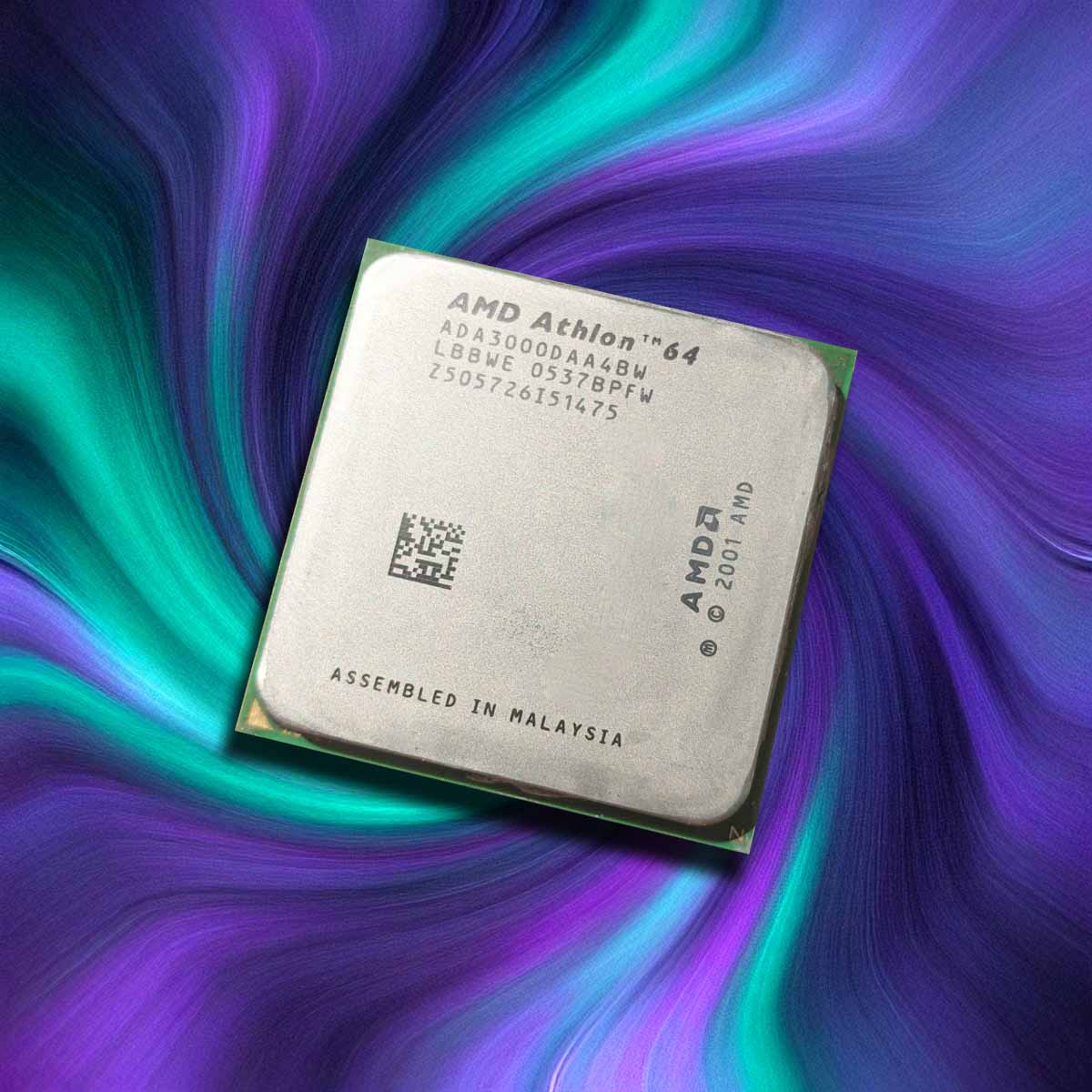
2. AMD Athlon 64 3000+
AMD smashed Intel in the face, very hard, when it unleashed its first Athlon 64 chips at the end of 2003, introducing a brand-new chip design that made Pentium 4 look very silly indeed. The key buzzword, of course, was 64-bit. Intel was adamant that 64-bit instructions weren’t needed for consumer desktop PCs, and only introduced them on its enterprise-level, much-derided Itanium chips. AMD saw things differently and launched a new range of CPUs equipped with its own 64-bit extensions to the x86 instruction set, called AMD64.
There was an element of numerical willy-waving going on here, of course. There wasn’t a 64-bit version of Windows XP at this time, which meant most desktop users were still running 32-bit software on their new 64-bit chips. That all changed a few years down the line, when it became clear that PCs needed to be able to address more than 4GB of RAM, among other reasons, but we do have AMD to thank for getting the 64-bit ball rolling.
For the first time, it brought us an integrated RAM controller in the same die as the CPU core
Crucially, AMD64 was an incredible piece of 32-bit silicon as well. For the first time, it brought us an integrated RAM controller in the same die as the CPU core, rather than relying on your motherboard’s Northbridge chip to do the work. Importantly, too, Athlon 64 chips were significantly more powerful than Intel’s rival Pentium 4 CPUs, in terms of both gaming and number crunching. Not only that, but they demanded less power and ran cooler, with AMD’s Cool’n’Quiet tech dynamically adjusting voltage and clock speed according to workload.
A big factor here was the number of pipeline stages. A standard Pentium 4 had 20 stages in its integer pipeline at this point, compared to just 12 for the first Athlon 64 chips. A longer pipeline enables higher clock speeds, which made Intel’s chips look good in specs list, but it could also have a catastrophic effect on performance in unpredictable workloads. If your CPU can’t get instruction from its cache, then the whole pipeline needs to be flushed out before it can start again, wasting a lot of work and hitting performance hard. Mispredicts are a painful thing in the CPU world.
It didn’t matter that the Athlon 64 3000+ only ran at 1.8GHz – AMD just made sure it had “3000” in the model name, and then it could compete with a 3GHz Intel Pentium 4. Enthusiasts loved it. Innovative, efficient, and extremely powerful, Athlon 64 set the standard for today’s 64-bit chips, while showing AMD could absolutely beat Intel when it focused its efforts.
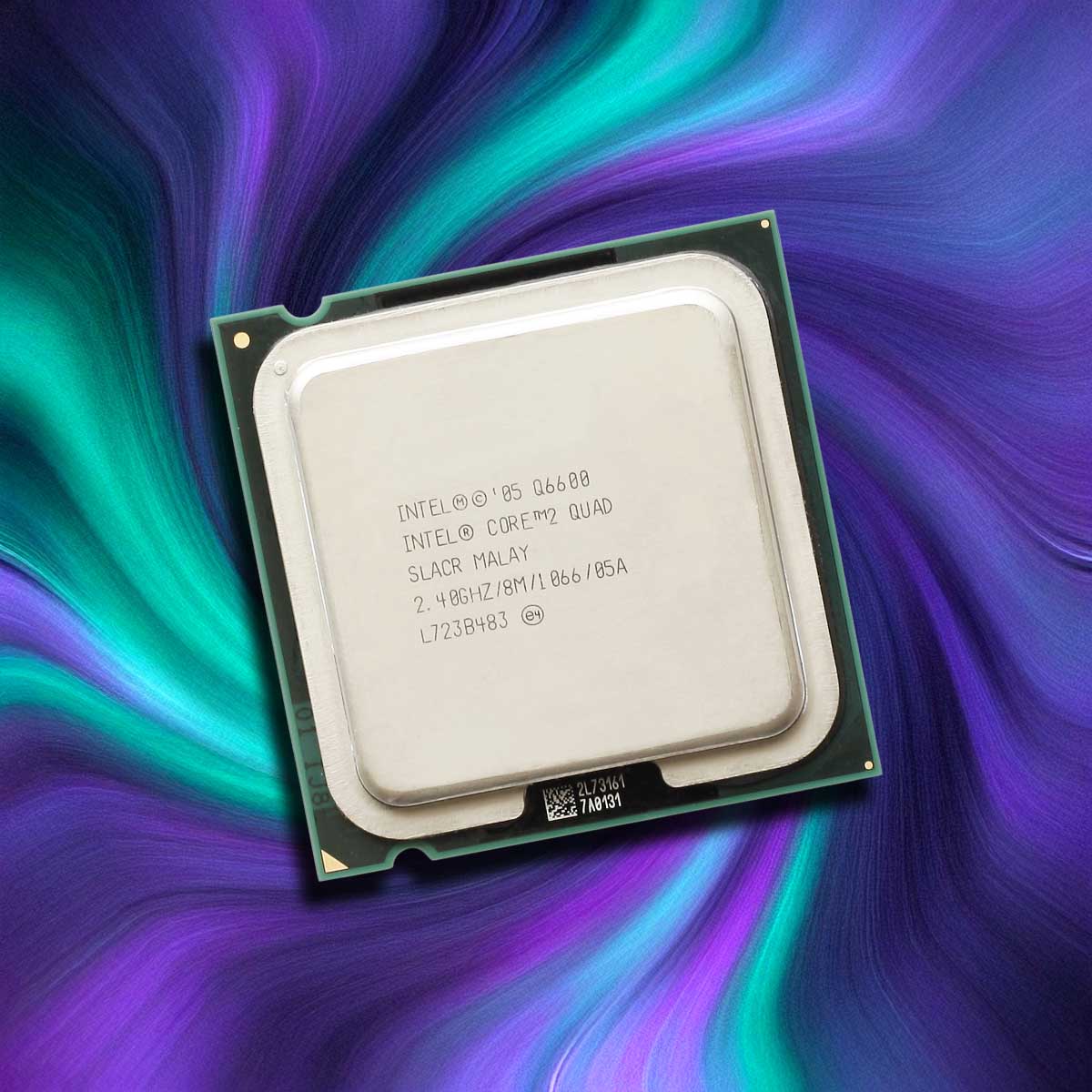
1. Intel Core 2 Quad Q6600
Just a couple of months after Intel ditched its woeful NetBurst architecture and launched its first Core 2 Duo chips, the company rapidly redrew the battle lines by unleashing a range of quad-core chips. The new Core 2 Quad lineup was astounding at the time – we’d only just got used to the idea of chips with two cores, and now we already had four? It blew our little minds back in 2006.
They weren’t cheap at first, with the multiplier-unlocked Core 2 Quad QX6700 demanding a massive launch price of £899. But then, just two months later, in January 2007, Intel released a version that was half the price and very nearly as fast. Almost instantly gaining legendary status, the Core 2 Quad Q6600 had the same four Kentsfield cores as the QX6700, and 8MB of L2 cache. It was basically exactly the same chip, but with a 9x multiplier instead of 10x.
That meant it ran at 2.4GHz rather than 2.66GHz, and, unlike the QX6700, it was also multiplier-locked, so you couldn’t easily overclock it (though lots of people did overclock it via the FSB). That didn’t matter when you could get an amazing quad-core chip for under £500, though. What’s more, you didn’t even need a new motherboard to run it. You could install one in an old Pentium 4 975X motherboard from 2005, as long as you updated the BIOS.
We’d only just got used to the idea of chips with two cores, and now we already had four? It blew our little minds
The price steadily dropped further, and then, later in 2007, a refined version with G0 stepping came out. With a lower TDP, more overclocking headroom, and a price under £300, the G0 Q6600 became the go-to chip for enthusiasts. A jewel in the crown.
Of course, barely any games used more than two cores at this point, but Kentsfield was also strong in single-threaded software, and you had those extra four cores for multi-threaded workloads. At this point, they were really handy for bragging rights on the Folding@home leaderboard among enthusiasts, as well as running SuperPi.
Ahead of its time, supremely powerful, and affordable, if you bought a Q6600 you wouldn’t need to upgrade for several more years. I didn’t retire mine until I upgraded to a Core i7-3770K in 2013, and I was still using an old 975X Pentium 4 motherboard with it. It took another ten years before Intel made a mainstream desktop CPU with more than four cores, when the six-core Core i7-8700K finally responded to the threat from AMD’s new Ryzen CPUs in 2017.

Honourable mentions
With over four decades of CPUs under the PC’s belt, it’s hard to whittle down the greatest CPUs to just ten, even if you limit yourself to x86. Several others also stood out to us, from the grandaddy of them all, the 8086, to AMD’s first 16-core desktop chip, the Ryzen 9 3950X.
Any PC gamer who owned a 486 DX2/66 will also remember how well it ran Doom, and I have a particular soft spot for Intel’s Celeron 300A. The latter was a Slot 1 chip with 128KB of on-die L2 cache, often making it quicker than a Pentium II with 512KB of L2 cache on separate chips. If you had a good enough cooler, you could sometimes even overclock it to 450MHz by pumping up the FSB to 100MHz – it was better than most Pentium II chips at the time.
Anyway, here are some of the chips that didn’t quite make the cut, and would certainly have made it to a top 20.
- Intel Celeron 300A
- Intel 8086
- Intel 486 DX2/66
- AMD Ryzen 9 3950X
- AMD K6-III 450MHz
- AMD Athlon XP
We hope you’ve enjoyed this retrospective look through some of the finest processors in the PC’s history. If you liked this feature, then make sure you also check out our guide to the top 10 GPUs ever for a similar journey through graphics history. Plus, if you want to buy a new CPU now, check out our full guide to buying the best CPU for your needs.


